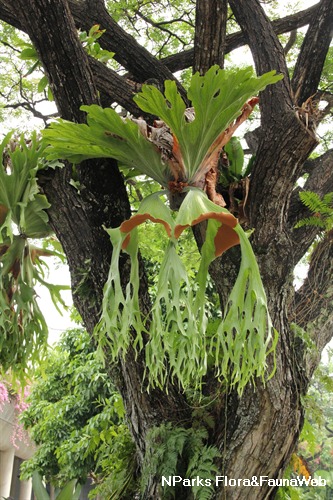
Back
Platycerium ridleyi Christ.
| Family Name: | Polypodiaceae |
| Common Name: | Ridley's Staghorn Fern |
Ridley’s Staghorn Fern was named after the first director of the Singapore Botanic Gardens, Sir Henry Nicholas Ridley, who made exceptional contributions to the region’s botany, natural history and economy in the 1880s. Unlike other species, Ridley’s Staghorn Fern produces unique upright forked leaves, which resemble a deer’s antlers!
Name
Classifications and Characteristics
| Plant Division | Ferns & Lycophytes (Non-Seed Vascular Plants) (Fern) |
|---|---|
| Plant Growth Form | Epiphyte |
| Lifespan (in Singapore) | Perennial |
| Mode of Nutrition | Autotrophic |
| Maximum Height | 0.5 m to 0.6 m |
| Maximum Plant Spread / Crown Width | 0.5 m to 0.6 m |
Biogeography
| Native Distribution | Thailand, Sumatra, Peninsular Malaysia, Singapore, Lingga Islands, and Borneo |
|---|---|
| Native Habitat | Terrestrial (Primary Rainforest, Secondary Rainforest, Freshwater Swamp Forest) |
| Preferred Climate Zone | Tropical, Sub-Tropical / Monsoonal |
| Local Conservation Status | Native to Singapore (Extinct (EX)) |
Description and Ethnobotany
| Growth Form | This fern plant consists of a rhizome (horizontally growing stem) that bears nest-leaves and repeatedly forked, ascending foliage leaves. |
|---|---|
| Foliage | It produces two kinds of fronds. The infertile nest-fronds are corrugated, 20–50 by 20–40cm, and fold over one another to form an enclosed chamber with rounded base attached to host surface. The fertile fronds are 25–50 cm long or more, forked, stiff and leathery, grow upwards, resembling stag's antlers. |
| Reproductive Parts - non-flowering plant | The lobes that bear the sporangia (spore-producing structures) are reverse egg-shaped to elliptic, and 5–17 by 3–15 cm. There are eight spores per sporangium. |
| Others - Plant Morphology | It is the only species of Staghorn Fern with ascending fertile fronds. |
| Associated Flora | It is often found in association with Lecanopteris species (Ant Ferns). |
| Associated Fauna | Its nest-fronds are often colonized as nesting area by ants in the wild. |
| Cultivation | Fern can be mounted onto tree branch/ trunk, or fern root slabs (which need daily misting). |
| Etymology | Species named after British botanist and first director of Singapore Botanic Gardens from 1888 to 1911, Henry Nicholas Ridley, who discovered the plant in Bukit Timah forest (Singapore). |
Landscaping Features
| Landscaping | It forms reticulated nest-leaves. The fertile foliage-leaves also extend upwards, unlike other Platycerium species. |
|---|---|
| Desirable Plant Features | Ornamental Foliage, Ornamental Form |
| Landscape Uses | General, Vertical Greenery / Green Wall, Interiorscape/ Indoor Plant, Suitable for Roadsides, Parks & Gardens, Small Gardens |
| Thematic Landscaping | Naturalistic Garden |
Fauna, Pollination and Dispersal
| Seed or Spore Dispersal | Abiotic |
|---|
Plant Care and Propagation
| Light Preference | Semi-Shade, Full Sun |
|---|---|
| Water Preference | Moderate Water, Occasional Misting |
| Plant Growth Rate | Slow |
| Rootzone Tolerance | Shallow Media |
| Maintenance Requirements | Moderate |
| Pruning | No pruning required. |
| Propagation Method | Tissue Culture, Spore |
Foliar
| Foliage Retention | Evergreen |
|---|---|
| Mature Foliage Colour(s) | Green |
| Mature Foliage Texture(s) | Leathery |
Non - Foliar and Storage
| Stem Type & Modification | Acaulescent |
|---|
Image Repository
Others
| Master ID | 267 |
|---|---|
| Species ID | 1563 |
| Flora Disclaimer | The information in this website has been compiled from reliable sources, such as reference works on medicinal plants. It is not a substitute for medical advice or treatment and NParks does not purport to provide any medical advice. Readers should always consult his/her physician before using or consuming a plant for medicinal purposes. |




.jpg)


